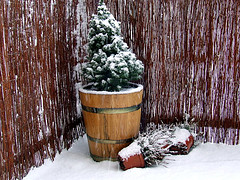How to Winterize Your Irrigation System
 If you live in an area that rarely sees extremely cold temperatures, you may not realize the importance of winterizing irrigation systems. However, even mild climates like those along the West Coast can see hard freezes in the early hours of the morning, so it’s important to prepare your irrigation sprinkler system for winter by clearing it of all water.
If you live in an area that rarely sees extremely cold temperatures, you may not realize the importance of winterizing irrigation systems. However, even mild climates like those along the West Coast can see hard freezes in the early hours of the morning, so it’s important to prepare your irrigation sprinkler system for winter by clearing it of all water.
As an irrigation services expert can tell you, the danger of not winterizing your system is that if water freezes inside it, the components of the system could crack and break. Recall that water expands as it freezes. PVC and polyethylene piping is often used for building irrigation systems, and both types of piping can crack if water freezes inside. If you leave the water in your irrigation sprinkler system over the winter, you may find that you’ll need to pay for irrigation services once spring arrives, to replace broken parts.
If you are comfortable working with your home’s irrigation systems yourself, follow the instructions below to prepare for winter. If you don’t have the time or expertise to complete this task on your own, call for an irrigation services provider to winterize your irrigation sprinkler system for you.
In general, there are three basic steps to shutting down irrigation systems:
1. Turn off the water valve running to the system.
2. Deactivate the system by setting the irrigation controller to the off position.
3. Remove water from any part of the system that may freeze.
Note that those in temperate climates that never experience deep soil freezes may have slightly less work; they may not even need to drain off water from the underground components. Read on for more detailed descriptions of each step.
1. Turn off the water running to your irrigation sprinkler system.
Locate and turn off the main water valve running to your irrigation system. The main valve should be protected from freezing temperatures; it is often located inside an irrigation box buried in the ground below the frost line. Alternatively, it may be wrapped with protective insulation or be located in your home basement. If you don’t have a main shut-off valve for your irrigation systems, arrange for an irrigation services provider to install one for you.
2. Deactivate the irrigation system by adjusting the controller.
Most irrigation sprinkler systems are automated so as to relieve homeowners of the hassle of remembering to turn the water on every day. Depending on the type of controller you have, you will want to follow the guidance below.
Irrigation controllers come in two main types: those with a digital readout, and those with a manual turning dial. Digital controllers should be turned to the “Off” setting for the winter months. This will maintain all of your settings while preventing the system from turning on. When a system is in the “Off” mode, all power is cut off to the valves in the irrigation system while still maintaining the controllers programming information for next season.
If your irrigation controller features a dial somewhat similar to a clock face with no digital read-out, you should turn off the power to the controller to save energy. (In this type of system, there are no settings to lose.)
3. Drain off water from any irrigation system parts that could freeze.
There are many parts of your irrigation/sprinkling system that must be completely emptied of water before winter arrives. There are three basic methods to removing water from irrigation systems:
Manual draining. Manual draining involves manually turning off all valves and shaking out any extra water from sprinkler parts. Manual valves are typically located at the end and low points of irrigation systems. Open all valves, let the water drain out, and make sure to also drain any water between the system’s shutoff valve and the backflow device. (Backflow devices prevent the pollution of drinking water by stopping backflow from irrigation lines to potable water lines.) The cocks on the backflow device should also be opened. Also open any valves on individual sprinklers. If your sprinklers do not have valves installed on them, you may need to actually shake each sprinkler until all the water comes out.
Manual draining is rarely recommended except for the most experienced homeowners, since water can remained trapped in the system even after you’ve drained as many valves as possible. Most people who are knowledgeable about irrigation services recommend calling in a professional to conduct “blow out” draining instead.
Automatic draining. Automatic draining is possible if your system is equipped for it. In these systems, drainage automatically occurs when pressure in the system is lower than 10 PSI. Next, follow the steps listed above for checking water between the shutoff valve and the backflow device, and for removing water from sprinkler heads.
Blow-out draining. This type of draining uses compressed air to blow all extra water out of irrigation systems. This is a very effective method if done correctly. However, because this method can cause damage if done incorrectly, you should definitely call in an irrigation services professional to blow out your irrigation systems for you.
[Photo by: Trochej]
